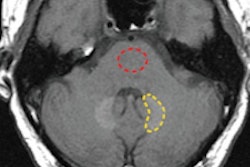Radiology departments and imaging centers that switch their preferred MRI contrast agent should watch for an increase in allergic-like reactions in patients, but the jump could be due to an epidemiological phenomenon rather than actual differences in the products, according to a study in the March issue of Radiology.
Researchers from the University of Michigan Health System noted a statistically significant increase (0.34% vs. 0.08%) in reports of allergic-like reactions at their institution approximately two years after changing to gadobenate dimeglumine. However, in the third year of use, the rate of allergic-like reactions declined considerably.
What's the explanation for the dramatic rise and steep fall in allergic-like reactions? The authors cited the Weber effect.
"The Weber effect is a known phenomenon in the epidemiology literature in which the number of spontaneously reported adverse events for a drug tends to peak around the second year after its introduction," wrote Dr. Matthew Davenport and colleagues. "Although not all drugs exhibit a classic Weber effect, it is known to often occur" (Radiology, March 2013, Vol. 266:3, pp. 773-782).
NSF risk
The concern of possible allergic reactions to gadolinium-based contrast agents peaked in 2006 with the news that some patients with severe renal impairment were developing nephrogenic systemic fibrosis (NSF). Since then, imaging facilities and radiology departments have implemented protocols to cull patients who may be at risk for NSF, such as those with an estimated glomerular filtration rate (eGFR) of less than 30 mL/min/1.73 m2.
For the current study, Davenport and colleagues identified 105,607 intravenous administrations of gadolinium-based contrast media within the university health system between January 1, 2007, and June 30, 2012. They chose that particular date range because it spanned two years before and 3.5 years after a change in the contrast supply contract.
In 2007 and 2008, University of Michigan's contrast agent supplier was Bayer HealthCare Pharmaceuticals, which provided Magnevist (gadopentetate dimeglumine). In the first quarter of 2009, the university switched its contract to Bracco Diagnostics for MultiHance (gadobenate dimeglumine).
"A 3.5-year period (instead of a two-year period) after this switch was chosen to account for the Weber effect, which can be responsible for transient elevations in the rates of adverse events after introduction of a new drug or changes in use of an existing drug and which tends to peak in the second year," the authors wrote.
The authors counted 31,540 administrations of gadopentetate dimeglumine and 66,152 administrations of gadobenate dimeglumine during the study period.
Regarding other agents, gadoteridol (ProHance, Bracco) was used for 5,907 administrations. Gadoxetate disodium (Eovist, Bayer) was given for hepatobiliary imaging in 1,948 administrations, and gadofosveset trisodium (Vasovist, Bayer) was used for MR angiographic exams in 36 cases. Gadodiamide (Omniscan, GE Healthcare) was used for 24 administrations.
Allergic-like reactions
Davenport and colleagues classified allergic-like reactions as mild, moderate, or severe according to previously published guidelines. Mild allergic-like reactions were conditions such as hives, nasal congestion, and sneezing. Moderate allergic-like reactions included skin inflammation, shortness of breath, wheezing, or a trip to the emergency department. Severe reactions included anaphylactoid shock, severe laryngeal edema, cardiopulmonary collapse, or hospital admission.
There were 162 allergic-like reactions among the 105,607 total injections of gadolinium-based contrast media, for an overall rate of 0.15%. Among the 162 reactions, 137 were mild, 19 were moderate, and six were severe.
There was no significant difference in the degree of allergic-like reactions between male and female patients, according to the authors. There were 42 reactions among 40 male patients and 120 reactions among 114 female patients.
In addition, pediatric patients (eight reactions, or 0.05%) and adults older than 65 years (15 reactions, or 0.07%) had a significantly lower rate of allergic-like reactions associated with all gadolinium-based contrast media, when compared with patients between 18 and 65 years of age (139 reactions, or 0.20%).
Rate differences among agents
The allergic-like reaction rate for gadobenate dimeglumine peaked in the second year after it replaced gadopentetate dimeglumine, with a maximum per quarter of 0.38% (16 reactions from 4,262 injections). The maximum per quarter for gadopentetate dimeglumine was 0.10% (four reactions from 4,122 administrations).
By the last three quarters of the study, the gadobenate dimeglumine allergic-like reaction rate had dropped to 0.12% (17 reactions from 14,387 administrations) and did not significantly differ from the original baseline rate of gadopentetate dimeglumine.
Overall, gadobenate dimeglumine was associated with significantly more allergic-like reactions (123 out of 66,152, 0.19%) than gadopentetate dimeglumine (24 out of 31,540, 0.08%).
Gadobenate dimeglumine was also associated with significantly more mild reactions. However, the frequency of moderate and severe reactions did not significantly differ between the two contrast agents, according to the authors.
Similar comparisons with gadoteridol, gadofosveset trisodium, and gadodiamide were difficult due to the low number of administrations of those agents, Davenport and colleagues noted.
Perhaps the best news is that no patients at the University of Michigan died of allergic-like reactions related to any of the gadolinium-based contrast agents during the study period.
A peak in reported allergic-like reactions occurred in the second year after gadobenate dimeglumine replaced gadopentetate dimeglumine at the university, which could be explained by the Weber effect, Davenport and colleagues concluded.
"The influence of the Weber effect suggests that the increase in adverse events associated with gadobenate dimeglumine in our study could be attributed to epidemiologic reporting bias and may not reflect a true difference in adverse events based on the pharmacologic structure of the contrast medium," they wrote.




















